Jamzilla could be a monster
February 13, 2014
With officials keeping a close eye on the weather report and a couple of major sporting events, the gargantuan road-paving and lane-painting operation known as Jamzilla roars into action on the 405 Freeway this weekend.
In the days leading up to the 80-hour construction marathon, which runs from February 14-18, the weather forecast has been of more than casual interest. That’s because a cornerstone of the planned work—a costly, fast-hardening polyester paving process that allows the contractor to move far more quickly than would be possible with conventional paving materials—requires temperatures above 50 degrees (and below 100 degrees) to work properly. With a warming trend pushing overnight lows into the 50s, officials held a “go/no-go” meeting on Wednesday and decided to proceed with the effort, which is a key milestone in the long-running project to bring a 10-mile northbound carpool lane and other improvements to the 405.
But the thermometer hasn’t been the only preoccupation as Jamzilla approaches.
Officials also are worried about the human factor.
While L.A. sailed through two previous weekend-long “Carmageddons” in which the entire 405 was shut down, this time around may be a different story—paradoxically, because the freeway will actually have a couple of northbound lanes open during the daytime all weekend long, as well as all of the southbound lanes.
“When the freeway is closed, it’s easy for someone to make the decision. But with lane reductions, it means there’s always a chance. There’ll be some people who’ll just go there and see what happens,” said Edward Yu, who directs the city of Los Angeles’ Automated Traffic Surveillance and Control Center (ATSAC), which will be closely monitoring the flow of traffic as Jamzilla unfolds.
Also, unlike during either of the previous Carmageddons, there are a couple of big sports events scheduled in the area and expected to draw thousands of spectators: the Northern Trust Open at the Riviera Country Club, starting Thursday and running through Sunday, February 16, and the UCLA-University of Utah basketball game at Pauley Pavilion on Saturday.
The Getty Center, meanwhile, is open for visitors and showcasing a Queen Victoria film series this weekend, along with ongoing exhibitions. Another Sepulveda Pass institution, the Skirball Cultural Center, is offering its regular weekend lineup of programs.
Metro, which is running the 405 Project in conjunction with Caltrans, estimates it will need to reduce the regular traffic volume on the 405 by two-thirds just to keep things moving normally.
Anything else, they warned this week, could produce an “80-hour-long Sigalert.”
“If we don’t have enough people staying off the freeway, we will have long congestion lines. That’s guaranteed,” said Metro spokesman Dave Sotero. “One-and-a-half or two hours stuck on the freeway is no fun for anybody—and it could be even worse.”
He’s not just blowing smoke. A shorter, but otherwise similar paving operation last March, billed as “Son of Carmageddon,” caused lengthy traffic jams on the 405, Sepulveda Boulevard and beyond.
“We had northbound traffic backed up to the 90. The 10 was gridlocked in both directions leading to the 405,” recalled Sotero, who memorialized the occasion with a frame grab of all the red lines depicting clogged roadways on that day’s Caltrans QuickMap.
It doesn’t have to be that way this weekend.
Anyone who doesn’t need to drive should make it a car-free weekend, Metro advises. Those who do need to travel should steer clear of the construction zone and choose other freeways to get around.
And everybody who plans to be in motion anywhere near the 405 this weekend, including on the Presidents’ Day holiday Monday, should make it a point to be up to date on exactly where and when Jamzilla is taking place.
Full details are here, but in a nutshell, this is what’s happening:
The affected area is a 5.6-mile stretch of the northbound 405 between Getty Center Drive and Ventura Boulevard.
During the daytime hours, three northbound lanes will be closed, with two left open.
At night, all five northbound lanes will be closed.
The entire operation should wrap up in time for back-to-work traffic at 6 a.m. on Tuesday, February 18.
Unfortunately, this is not the final extended closure planned for the project, which is expected to be “substantially completed” and open for driving by summer.
A 55-hour closure of the southbound freeway is now in the planning stages. A date has not yet been set, but K.N. Murthy, Metro’s executive director of transit project delivery, said the upcoming extended shutdown is needed to work on retaining walls, sound walls, shoulder paving and lane restriping.
When the $1 billion-plus project finally reaches the end of the road, it will leave behind the 10-mile-long carpool lane, three rebuilt bridges and some dramatically reconfigured Wilshire “flyover” ramps, along with other improvements.
Another benefit, for transit riders, may in the offing as well.
When the new carpool lane opens this summer, Metro is considering using it to introduce a new rapid bus line between the San Fernando Valley and the Westside. If approved and funded by Metro’s Board of Directors, the new line could offer service from the Valley to Westwood beginning this summer, and would extend further south to connect with the Expo Line when the second phase of the light rail opens to Santa Monica in 2015.
Posted 2/13/14
Record numbers riding easy on Expo
January 29, 2014
The first phase of the Expo Line is getting up to speed—six years ahead of schedule.
Metro had projected the line would be carrying 27,000 riders a day by 2020. It has been surpassing that mark since last fall. In December, an average of 27,360 rode it every weekday.
And, in a win-win for passengers and the transit agency, the line’s success hasn’t translated to overcrowded train cars, at least so far.
Tiffany Laurence, 24, uses Expo to commute from downtown Los Angeles to Culver City. She said that seats are plentiful, even during the morning and evening rush.
“Those are the only times I have someone sitting next to me,” Laurence said. “Normally, I have a whole row to myself—it’s so luxurious.”
Bruce Shelburne, Metro’s rail operations chief, is also glad for the extra room. He said the line will need the seating capacity when the second phase to Santa Monica opens in 2015. Shelburne expects that to draw flocks of commuters and tourists, even on the weekends. “We’re not breathing hard and we’re at 27,000,” he said. “If we were at 40,000 I’d be awfully nervous.”
For now, the extra room offers easygoing rides to people like Jerry Davis, a Houston, Texas, city councilmember who was in town on business on a recent Wednesday.
“The only lines we’ve seen have been the traffic lines, so it makes us want to come to the rail,” Davis said. “It’s a nice, sunny day—we’re putting less emissions into the air and saving the environment.”
Samantha Bricker, Chief Operating Officer for the Exposition Rail Authority, said much of the ridership comes from the numerous entertainment venues and institutions that are along the way, like Staples Center and the University of Southern California. She also said the line draws a lot of people from the Westside. A 600-space park-and-ride lot at the Culver City station—the furthest west spot on the Expo Line so far—regularly fills to capacity in the morning.
Aside from getting people from Point A to Point B, Expo also seems to be changing how they live. Sandip Chakrabarti, a Ph.D. candidate in urban planning at USC, has been studying how the Expo Line has affected the way people who live in the area get around. “There is evidence that it has altered travel behavior quite a bit,” he said. “People near Expo stations have been driving a lot less.” On a personal note, he said that when the line starting running it enabled him to move from an area near the school to Culver City, which he prefers.
For commuters like Peyton McElyea, who takes the rail to his real estate job in downtown Los Angeles, a major part of driving less is being able to use travel time more productively.
“You can read the Wall Street Journal, the morning paper, you can respond to email,” said McElyea. “You know you have that 30-minute block where you can get something done. It’s better than being there with your hands on the wheel.”
Metro’s Shelburne said McElyea’s perspective is not uncommon; rail transit is generally becoming more popular across the board.
“The train’s sexy, that’s the bottom line,” Shelburne said. And the unpredictable traffic on the frequently-gridlocked 10 Freeway doesn’t hurt that appeal. “The train is dependable. It’s going to be that way every day.”
Posted 1/21/14
Cycling’s marquee player
January 29, 2014
A “Super Bowl Sunday Funday Warm-Up Ride” offers a healthy diversion before the coming onslaught of game day nachos, truck ads and football.
Next month, a benefit screening of the 1979 feel-good cycling flick “Breaking Away” gives a boost to “Operation Firefly,” a program of the Los Angeles County Bicycle Coalition (LACBC) that provides bike lights to folks who need them to ride safely at night.
And in April, “Climate Ride California” spins through the northern part of the state, raising funds for non-profit environmental and alternative transportation organizations, including the LACBC, which is sending a team.
A common denominator in all three events? Greg Laemmle, president of the 75-year-old local theater chain and an increasingly visible advocate for bicycling in Los Angeles.
These days, in fact, it’s hard to miss him: he’ll be the guy leading that Super Bowl Sunday ride from the North Hollywood Red Line station to Griffith Park and back. (He did it last Super Bowl Sunday, too, with an L.A. football history-themed itinerary stretching from the Coliseum to the Rose Bowl.)
He’ll also be at the “Breaking Away” fundraiser, which takes place Feb. 12 at Laemmle’s NoHo 7. And he’s captaining the LACBC’s team for the Climate Ride, which is being promoted with a “Ride with Greg Laemmle Contest” featuring movie pass prizes and contributions toward riders’ fundraising goals.
In other words, he may be an off-screen player in the movie biz, but in the local cycling world, he’s an above-the-line star.
“He’s a great face for our cause and the set of causes he supports,” said LACBC executive director Jennifer Klausner, noting that the Laemmle name is “synonymous with Los Angeles,” especially among art film devotees.
“We feed on the passion that he has for a wonderful future vision of a liveable Los Angeles,” Klausner said.
Although Laemmle, 48, has early memories of riding his bicycle at the beach and to Franklin Elementary School in Santa Monica, it wasn’t until gas prices spiked in 2007 that he felt moved to take things to the next level. He became a bicycle commuter between his home in Century City and his company’s office over the Royal Theater in West L.A.
Since that time, he has joined the LACBC board and become something of a two-wheeling role model, hoping to persuade fellow Angelenos to give cycling a try, particularly for the most common trips of three miles or less.
Beyond his daily bike commute, Laemmle and his wife, Tish, a top fundraiser for the popular annual River Ride, bicycle all over town.
“It’s crazy to get to the Hollywood Bowl by car, and sometimes it’s a lot of fun to ride your bike there,” Laemmle said. “I ride to Dodger Stadium and, to their credit, the Dodgers have added bike parking. We rode downtown to see a play yesterday at the Ahmanson.”
The couple ended up taking the Expo Line home from that one—making it a “multi-modal” outing involving both bikes and light rail.
“As Metro expands, the opportunity to combine Metro transit with bicycling really opens up a lot of possibilities for getting around,” Laemmle said.
He acknowledges that there are dangers out there for cyclists interacting with cars on L.A. streets, although he said he hasn’t personally experienced any mishaps.
“I have almost never encountered a situation where a driver is aggressively acting in a dangerous manner,” Laemmle said. “For the most part, people are really kind. As long as you’re happy about sharing the road, a lot of people are prepared to do that.”
Off the road, Laemmle, as a third-generation movie guy, naturally has some cinematic cycling favorites that cut across genre lines.
“ ‘Breaking Away,’ that’s an obvious one. There are definitely some other good bike movies, too. ‘The Bicycle Thief.’ And ‘Pee-wee’s Big Adventure’ has some nice bicycling scenes.”
Laemmle’s bike-friendly world view shows up in his workplace, where he has installed showers for the use of fellow bike commuters. Those include his dad, Bob, the firm’s chairman, who has now retired but still comes to the office regularly on two wheels.
Greg Laemmle said some have questioned whether bike advocacy makes sense for a business owner’s bottom line.
“I was at one point advocating for bike lanes on Lankershim, in front of where the NoHo theater opened up two years ago, and there was a comment, ‘I doubt Mr. Laemmle really wants bike lanes if they’re going to slow cars down,’ ” Laemmle recalled.
Actually, yes he does. “First and foremost, we have to be forward-looking, both from an environmental standpoint but also from a business standpoint. Most studies will show that neighborhoods that slow traffic down…and have bike infrastructure and pedestrian infrastructure and so forth, actually see an increase in business.”
And then there’s this:
“If you don’t have to own a car, or can share a car between a couple, that’s a lot of savings. And, you know, those savings translate into more money to spend at restaurants and doing stuff locally. So for what you save not having to pay for parking when you go the movies, you can buy a tub of popcorn,” Laemmle laughed.
Posted 1/29/14
Orange Line’s “dismal” fare findings
January 16, 2014
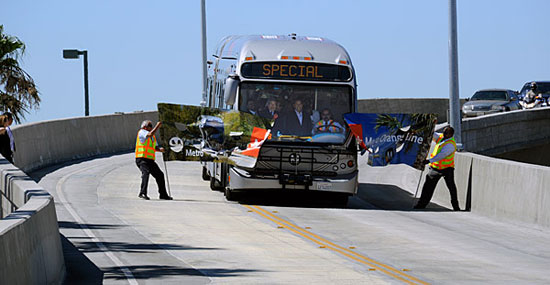
The Orange Line, shown at opening of the busway's extension, is popular but many aren't paying to ride.
Up to 22% percent of Orange Line passengers were deliberate fare evaders and as many as 9% “misused” their TAP cards, according to recent audits assessing the extent of fare-beating on the popular San Fernando Valley dedicated busway.
The findings, presented Wednesday to a Metro committee, are “rather dismal,” acknowledged Duane Martin, the agency’s deputy executive officer for project management.
“We understand there’s no glossing over the significant fare evasion,” Martin said, although he added that the recent redeployment of sheriff’s deputies to check fares along the line has improved the situation.
The Orange Line carries about 30,000 riders a day, and unlike the rest of Metro’s fleet, does not have fare boxes on its buses. Instead, it relies on patrons at un-gated stations to tap their fare cards at machines known as “stand alone validators.”
Many, it appears, have been taking advantage of the system to hitch a free ride.
Two audits—conducted December 3 and December 17—surveyed all patrons as they got off the bus at various Orange Line stations. The first audit, at the North Hollywood, Van Nuys and Sherman Way stations, found 22% fare evasion (traveling without a TAP card or using a card with no value on it) and 9% TAP card misuse (having a valid TAP card but, perhaps inadvertently, failing to properly tap it before entering the bus.) The second audit, at the North Hollywood, Reseda and Canoga stations, found 16% fare evasion and 8% TAP card misuse.
The audits were prompted by a November, 2013, motion by Supervisor Zev Yaroslavsky, a member of Metro’s Board of Directors and a longtime proponent of reforms to help eliminate free riders on the Los Angeles transit system. In a major milestone, gates on the L.A. subway, which for years had operated on the honor system, were finally latched last year. But locking down Metro’s light rail system and the Orange Line, which operates in a similar fashion, is still a challenge.
On Wednesday, Yaroslavsky and another director, Los Angeles City Councilman Paul Krekorian, responded to the Orange Line audit findings with another motion, this one directing Metro staff to explore installing gates at the busway’s stations. They also said that signs explaining that tapping is mandatory (and listing fines for failing to do so) should be placed on or beside the ticket validating machines at the stations.
Moreover, they asked for status reports on gate installation for projects currently being constructed or designed, including phase two of the Expo Line, the Foothill extension of the Gold Line, and the Crenshaw Line.
“Unless we take this issue head-on, and begin to design stations with gates…fare evasion will continue to skyrocket and become a perpetual problem with no end in sight,” the motion said.
“Saturating” the Orange Line with sheriff’s deputies checking fare cards has already started having an impact, including in the period between the first and second audit, Metro deputy executive officer Martin said.
“The deputies are out there so people started tapping again,” he said.
Before Martin reports back to Metro’s board members on the issue in March, he plans to conduct another Orange Line audit, probably next month.
Wiping out all fare evasion is unrealistic, he said, but there is lots of room for improvement. “I would love to be able to operate the system with plus or minus 2% or 3% fare evasion,” Martin said. “That’s the goal.”
Posted 1/16/14
Game on for Bruin, Trojan fare cards
January 15, 2014
The UCLA Bruins and USC Trojans are archrivals on the gridiron, but fans share a common interest: getting to the game in time for kickoff.
To that end, Metro Board members Zev Yaroslavsky (UCLA, Class of ‘71) and Ara Najarian (USC, Class of ‘85) have teamed up on a motion to have the agency develop specially branded Bruin and Trojan TAP cards for travel to home games during the 2014 football season.
There are good light rail alternatives for getting to both teams’ home stadiums; the Expo Line transports USC fans to the Coliseum, and the Gold Line is a shuttle ride away from Pasadena’s Rose Bowl, where the Bruins play. But getting on the train—especially if you don’t already have a TAP card loaded with funds to pay the fare—can cut into the convenience of leaving the driving to Metro.
“Often there are long queues to buy TAP cards and get onto the platform,” the motion said.
Enabling fans to buy a preloaded TAP card at the same time they order tickets through their respective university would “make the whole experience not only more enjoyable, but convenient, efficient and hassle-free,” the motion said.
On Wednesday, Metro’s Finance and Budget committee moved the motion forward to the transit agency’s full board for consideration.
Posted 1/15/14
This parking lot’s no paradise
December 6, 2013
On a chilly weekday morning, after squeezing his truck into the last available spot in the main lot at the Universal City/Studio City subway station, Mario Beltran summed up the parking situation in two words: “It’s terrible.”
“If you’re not here by 8 o’clock, you’re out of luck,” said Beltran, 36, as he hurried to catch a train to downtown L.A.
Beltran was lucky that day. According to some of his fellow commuters, lots are often filled up by 7:30 a.m. or even earlier at both of the Valley’s Red Line stations, in Universal City and in North Hollywood.
Some, like 25-year-old Joanna Sintek, who commutes from Burbank to the Natural History Museum in Exposition Park, have had to learn that the hard way.
“I would show up and get grumpy and have nowhere to park,” Sintek said. “I’d just drive instead.”
Since then, Sintek has discovered an L.A. County-owned overflow lot on Ventura Boulevard, but she said it’s a long haul from that lot to the station entrance, and it comes with an uncomfortable passage through a poorly-lit pedestrian tunnel beneath the 101 Freeway.
Parking can be tough in many parts of the city, but the two San Fernando Valley subway stations get extra pressure because they serve as the main transit gateways to Hollywood and downtown L.A.
Help may be on the way. On December 5, Metro’s Board of Directors unanimously passed a motion by L.A. City Councilman Paul Krekorian, County Supervisor Zev Yaroslavsky and Mayor Eric Garcetti, instructing the agency to investigate possible fixes, such as additional lots, parking garages or a joint development project to increase parking. The motion also directs staff to report back on bicycle and pedestrian improvements that could be made to the stations and surrounding areas.
There are currently 951 spaces at North Hollywood—300 of which are reserved at a cost of $39 per month. At Universal, there are 661 spaces, 140 of which are reserved. The County-owned satellite lot has 160 more spaces.
Robin Blair, Metro’s director of planning, said the agency already is in the process of installing a lot in North Hollywood that will accommodate 187 more vehicles, but he admitted the effort wouldn’t satisfy the rapidly-growing demand.
“There isn’t enough parking, that’s the bottom line,” Blair said.
Metro owns several parcels adjacent to the stations, but Blair is skeptical about building parking-only structures because of the high value of the land, which is located in popular areas like the NoHo Arts District and Universal City. “The sites are valuable as destinations and you are going to have pressure to do some sort of joint development,” he said. “Once you get in the discussion of parking garages, that’s not an option.”
The North Hollywood station is the northern terminus of the Red Line, and Blair said the “transit-shed” of the station—the geographical area from which it draws passengers—is enormous. It is used by about 33,500 people on an average weekday, bringing in people from North Hollywood, Burbank and much of the west San Fernando Valley via the Orange Line. Commuters from as far north as Palmdale drive to the station.
Because of that ridership and the potential for further growth, Blair hopes the station areas themselves can become destinations where people can eat, shop and hang out. That’s in sync with the motion’s intention to create “transit/mobility hubs” that would bring more riders into Metro’s system—and not necessarily just those who get there by car.
For bike advocates, new infrastructure is crucial because the stations border the Orange Line Bike Path, the Chandler Bikeway and a future section of the L.A. River Bike Path that’s in the pipeline. Those paths approach the stations but the parking lots were not designed for bicycle access, said Eric Bruins, director of policy and planning for the L.A. County Bicycle Coalition. He added that the stations bookend a stretch of Lankershim Boulevard where the group is pushing for bike lanes. “If you connect these two hubs with lanes, that neighborhood will really take off,” he said.
The move to create better access to the subway stations is one of three recent proposals that aim to improve the San Fernando Valley’s public transportation experience.
After residents around Pierce College complained that Orange Line patrons were urinating on their walkways and alleys because of a lack of bathrooms, Yaroslavsky, Krekorian and Supervisor Michael D. Antonovich moved to have the agency install bathrooms or come up with another solution. Their motion, adopted by Metro’s Board of Directors last week, also calls for the agency to look into adding bathrooms throughout its rail and bus rapid transit system. Blair said that could be a tall order, however; because of security and maintenance needs, having bathrooms at all stations could cost an estimated $70 million or more a year.
Finally, a motion by Yaroslavsky and Krekorian, adopted by the full board, seeks to curb freeloaders on the Orange Line, where fare evasion enforcement is falling short of the agency’s goal, with officers conducting checks only one-third as often as they should. Potential solutions could include increased enforcement, adding gates to stations, installing additional TAP card readers or improving signage.
For Carlos Mora, a commuter who has lived in transit-friendly cities like London and New York, such fixes are overdue steps toward improving what he calls “the crappiest infrastructure for public transportation ever.”
“It’s getting better,” Mora added, as he headed towards the parking space that he’d waited two months to reserve. “But if it was more these hubs where people could work and live and shop and entertain? That would be awesome.”
Posted 12/6/13
Smoking out an LGBT foe
November 14, 2013
With gay men, lesbians and bisexuals firing up far more frequently than heterosexual Californians, health officials are moving to create effective anti-smoking campaigns to persuade LGBT smokers that quitting is smart, community-minded and even sexy.
One project, being rolled out by the Los Angeles County Department of Public Health later this month, plans to take an edgy “break up with tobacco” message into gay bars and clubs.
Meanwhile, the state has released an anti-smoking video aimed at the LGBT community. The video, which shows a couple of handsome young gay men leaving a bar together, doesn’t just target smoking—it also emphasizes the importance of saying no to second-hand smoke. When one of the men starts to light a cigarette outside the bar, the other gently pushes it away from his lips as a voice-over announcer says: “It’s time to speak up. We have to protect each other.”
Nationally, the Centers for Disease Control and Prevention have showcased a lesbian bartender in the widely-watched “Tips from Former Smokers” national tobacco education campaign. The ads feature real people discussing the painful and at-times disfiguring effects of tobacco. Ellie, the bartender, never smoked herself but started having asthma attacks after years of exposure to second-hand smoke on the job.
It’s not the first time that public health officials have tried to confront the problem. Several years ago, for instance, Los Angeles County provided grant funds to several clinics to conduct LGBT-oriented smoking cessation programs. That campaign’s tagline: “Learn how to quit smoking without being scared straight. (As if you could be.)”
But a strongly-entrenched LGBT smoking culture remains, even as overall smoking rates in California have dropped over the past three decades.
Statistics released in June by the state Department of Public Health’s Tobacco Control Program show that gays, lesbians and bisexuals are more than twice as likely to smoke as heterosexuals—27.4%, compared to 12.9%.
More than a quarter of gay men smoke, compared to 16% of straight men, the state found. Among lesbians, 24.4% smoke—a rate 2½ times that of heterosexual women.
What’s more, second-hand smoke is dangerously widespread. More than 40% of gays, lesbians and bisexuals reported that they sometimes allowed smoking in their homes, compared to 23.4% of heterosexuals. The state report draws on data collected in the California Adult Tobacco Study from 2005 to 2010 among self-identified gays, lesbians and bisexuals.
The reasons for the high smoking rates can be complex.
For one thing, stress can be higher in the LGBT community, sometimes compounded by issues associated with coming out or family disapproval, said Susan Cohen, health education consultant for the L.A. Gay & Lesbian Center. Perhaps even more powerful, she added, is a strong bar culture that fosters an “unfortunate partnering of cigarette smoking and alcohol,” even though indoor bar smoking is now outlawed in California.
Others note that while an overall culture of disapproval of smoking and second-hand smoke has grown in recent years, it’s been slower to take hold in the LGBT community, where tolerance is a strongly-held traditional value.
“They’re basically loath to tell other LGBTs what to do or not do…That’s what we believe is translating into a more live-and-let-live attitude toward second-hand smoke,” said Francisco Michel, a media specialist with the state Tobacco Control Program.
Another challenge is confronting tobacco industry advertising aimed at the LGBT community. While some have decried the targeting, others see it, oddly enough, as a sign of respect.
“Some folks say, ‘See, we’re just like any other market,’ ” Michel said.
That’s why health officials believe it’s important, and effective, to fight fire with fire, offering another story line—preferably one that is sophisticated and engaging—to offset Big Tobacco’s persuasive tactics.
“I do think we have to continue with counter-messaging,” said Cohen, of the Gay & Lesbian Center. “The tobacco industry spends billions to get us to smoke.”
Posted 10/31/13
Gate latching hits a roadblock
September 26, 2013
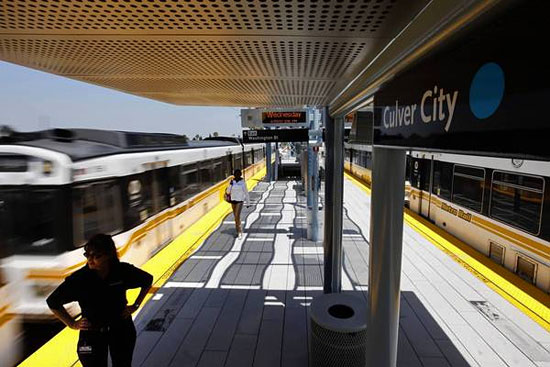
Elevated light rail stations, like in Culver City, are among the next targets for latching. Photo/L.A. Times
L.A.’s subway system has locked its gates and finally moved past an honor system that’s been in place for more than two decades. But it’s a different story at dozens of Metro light rail stations, which usually have stand-alone fare-card readers but no barriers to entry.
David Sutton, Metro’s deputy executive officer in charge of the gate-latching project, said that won’t change any time soon. Last week, in response to a July motion from several members of the Board of Directors, Sutton and his team released a report on the feasibility of installing lockable turnstiles on Phase 1 of Expo Line and at future stations throughout the expanding rail system.
“We’re not going to be able to lock them all,” Sutton said. “Some of the stations just don’t lend themselves to gates because of the space available and the cost.”
The primary reason is safety, said Rick Meade, who manages station construction for the agency. The National Fire Protection Association requires safe evacuation of platforms within 4 minutes in case of an emergency, as well as clearance to a “safe distance” within 6 minutes.
“As soon as you put gates on there, your exiting calculations are going to change because you have an obstruction that slows everything else down,” Meade said. Underground and aerial stations have space to accommodate enough gates for a swift exit, he said, but street-level stations usually do not. For those, increasing the size of platforms is often the only solution, a costly proposition that can encroach on traffic lanes or other property.
Some stations on the light rail system are already equipped with turnstiles, and their latching is slated for completion by February, Sutton said. On the Gold Line, the 5 out of 21 stations with turnstiles were latched earlier this month. Next up is the Blue Line, where 6 of 21 stations are scheduled to be latched in December, followed by all 14 stations of the elevated Green Line.
Along all Metro’s light rail routes, there currently are 41 stations where customers can enter without a barrier requiring payment, including the entire first phase of Expo Line. Sutton and his team examined the possibility of installing barriers at all non-gated light rail stations and have identified 13 for further analysis.
For Expo’s first phase, Metro estimates it would cost $3.1 million to add gates to three elevated stations, an investment the agency says could be recouped within 7 years because of increased fare collection. At the street-level stations, where there’s no room for gates, Metro is planning to add more stand-alone card validators at a cost of $173,000, plus $141,000 in annual operating expenses. Sutton said the non-gated card readers have been effective elsewhere in the system in reminding riders who want to comply with the rules to tap their fare cards.
“With gates and these kinds of things, it keeps honest people honest,” Sutton said.
Sutton said he plans to return to Metro’s Board of Directors in January with a full engineering analysis of what would be needed to install gates and additional card validators on Expo’s first phase, which goes from downtown to Culver City.
A similar gating scenario is being faced by Expo’s second phase, which will end in Santa Monica and is now under construction. At least two of the seven stations in that phase could not have locked gates, while four others are able to accommodate barriers and one other is being reviewed. For future rail projects that have yet to be designed or constructed, lockable gates will be required, Sutton said.
Meanwhile, on the Red and Purple lines, where gates have already been latched, preliminary data on fare collection for August is encouraging, showing a 22% increase in ticket machine sales over the same month last year—worth more than $614,000. Sutton said many free riders have left the system, opening more seats for paying customers.
The latched stations have also been a help to law enforcement, said Lieutenant Sergio Aloma, a transit services officer with the Los Angeles Sheriff’s Department, which is tasked with policing the system.
“Any time you can latch stations, it is better from a fare enforcement standpoint,” Aloma said. “I just wish we could latch them all.”
Aloma said latching even some gates allows officers to be deployed in larger numbers to non-gated locations. The increased visibility of law enforcement, he said, works as a deterrent to would-be fare evaders.
Aloma also said that, even at stations where gates are locked, dedicated scofflaws will find ways to beat the system by, for example, sneaking through access points for disabled people or jumping turnstiles. On the other hand, some riders may make honest mistakes such as forgetting to tap their fare cards when transferring lines as they try to figure out the new system.
“In some cases deputies have to use discretion and determine whether we need to take a customer-relations viewpoint or an enforcement viewpoint,” Aloma said. “This is still new and we want to educate folks on how to use the system.”
Posted 9/26/13
Expo shutterbug says so long
August 14, 2013
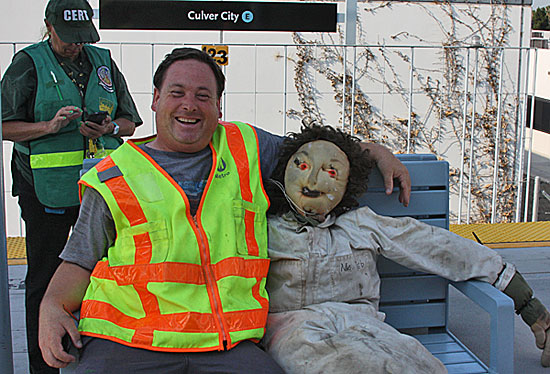
Dwight Sturtevant, aka Expo Line Fan, on the other side of the camera with Metro's crash dummy, Ms. Deb.
By profession, he’s a television engineer. But when he dons a fluorescent yellow vest and picks up his Canon EOS 40D camera, Dwight Sturtevant transforms into…Expo Line Fan.
At least he did until this week.
After nearly three years of chronicling the second, final phase of the Expo Line light rail project down to the last rivet and rebar, Sturtevant is leaving town for a new job in Ohio—and leaving behind a project he has documented in thousands of images and nearly three dozen videos since 2010.
Through it all, Sturtevant has worked anonymously and without compensation, with public credit for his photos going simply to “Expo Line Fan,” if it was given at all. But now, at last, his story can be told.
“I am just a rail fan who has been unofficially the project photographer,” the prolific volunteer said recently as he took a break from packing for the move. “I’ve had a free hand.”
Using his own photo equipment and wearing a Metro safety vest and a hard hat he purchased himself, Sturtevant has become a familiar figure on construction sites all along the 6.6-mile stretch where work is now underway to extend Expo from Culver City to Santa Monica.
His photos have appeared on Metro’s blog The Source, on the project’s website, on Supervisor Yaroslavsky’s website, in construction trade journals and on his own voluminous photo-sharing site.
“We use his pictures even in our office. It’s just built so much enthusiasm,” said Skanska USA Civil Executive Vice President Mike Aparicio, who added that Sturtevant’s outlook on the project has rubbed off on the whole Expo team. “When they see that kind of enthusiasm, they just feed on it.”
“He’s done a great job of capturing key milestones and highlighting progress,” Gabriela Collins, Expo’s government/community relations manager, said in a statement. “We thank him for sharing his wonderful photos and wish him well!”
While others have chronicled Expo’s progress in photographs, “Dwight has taken more than anybody,” and got unique shots because of his access to the construction process, said Darrell Clarke, a founder and co-chair of Friends 4 Expo Transit, longtime advocates for the project. “I’ve enjoyed his passion for following the project,” Clarke said.
Since his photo odyssey began, he has regularly delivered his copious output to the contractor, Skanska USA, to the Expo Construction Authority and to the Metro Library’s archives. It adds up: “If you figure every week since 2010, 200 pictures every week—do the math. It comes out to a lot of pictures.”
His connection to the project began—as so many L.A. adventures do—with a search for an alternate route. He was commuting at the time between downtown Los Angeles and the airport area and started to use Flower Street and Exposition Boulevard to get home. “And that’s when I went, ‘Wow, they’re building a light rail project.’ ”
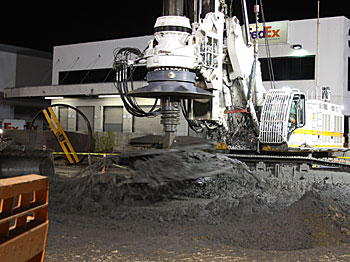
One of his favorites: time lapse shot of drilling for the Venice Boulevard Bridge. Photo/Dwight Sturtevant for Expo and Metro
When the company he was working for relocated to New Mexico, Sturtevant had more time on his hands and he was able to devote two days a week to photographing Expo.
“Over the last 2½ years, I’ve gotten the respect of Skanska where they’ve allowed me access to the project. Metro’s given me access to do certain things because I’ve earned the trust slowly, proved I wasn’t some nutcase,” he said.
He’s also become a familiar face to Metro’s train operators. For the past two years, he’s been printing up large posters with collages of his photographs to show them the project’s progress. He dropped off his last one at the 7th Street Metro Center last week, with a note: “To all my friends at Metro, I will miss you…I hope you have enjoyed the photos. Dwight S., aka the Expo Line Fan.”
Sturtevant, 51, said he has boyhood memories of looking at freight trains with his grandfather. His rail enthusiasm, literally, came with the territory: “I grew up in Boston. We had the first subway system in the country.”
His wife isn’t so keen on his hobby, however. He said her attitude is best summed up as: “If you’ve seen one train you’ve seen ‘em all.”
But he views his Expo work as a chance to make a difference, and to be an eyewitness to the construction of a light rail project that, in part, moves along the same route once traveled by the city’s late, lamented Red Cars.
“There’s not many places in the country where you’re able to watch cities regain what they’ve lost,” he said. “I mean, L.A. had all this once, and then we lost it.”
Sturtevant said he will be back for the project’s grand opening in 2015, and sooner if he can. In any case, the move to Ohio—where he’ll work for a mobile TV company that records professional sporting events—has at least one advantage for a train buff.
“The house has a big basement,” he said. “I’m going to be able to put my model railroad back up.”
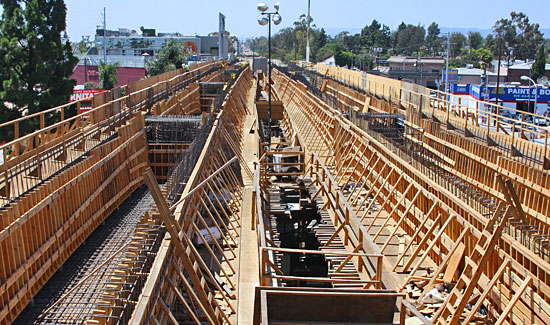
The Venice Boulevard Bridge, under construction last week. Photo/Dwight Sturtevant for Expo and Metro
Posted 8/13/13




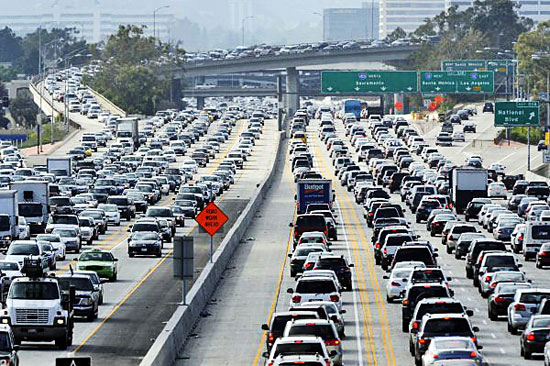

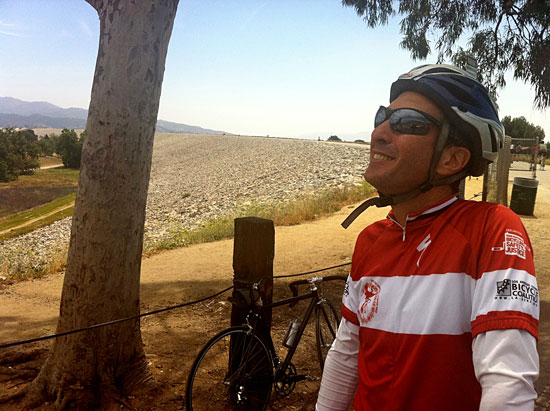
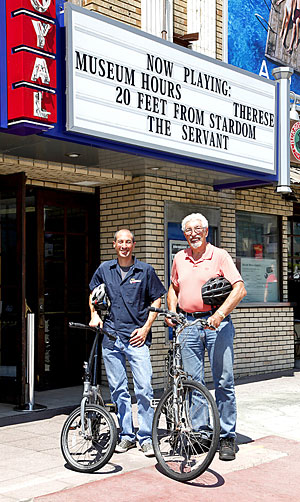
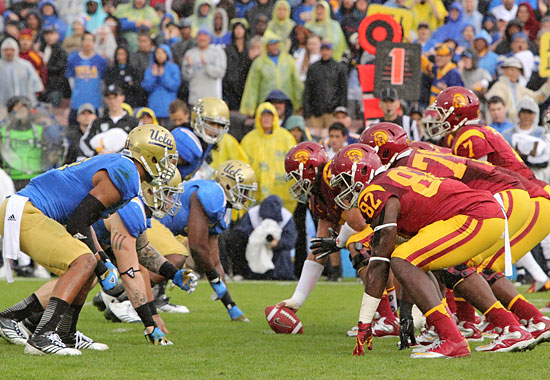
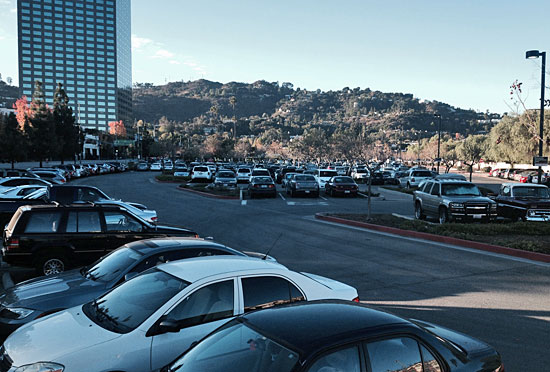
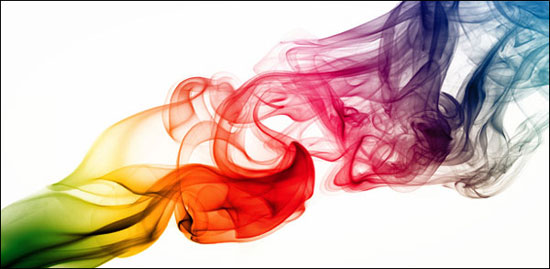
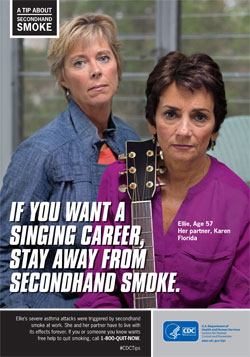
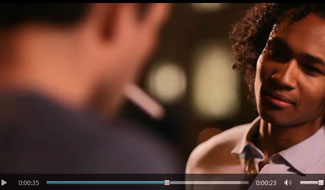
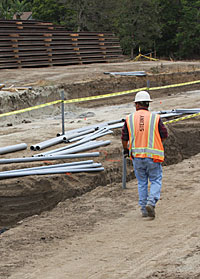







 405 bridge work causes a stink
405 bridge work causes a stink

